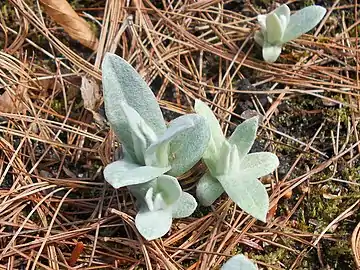Anaphalis margaritacea
Anaphalis margaritacea, commonly known as the western pearly everlasting[5] or pearly everlasting, is an Asian and North American species of flowering perennial plant in the family Asteraceae.
| Anaphalis margaritacea | |
|---|---|
 | |
| Corymb of capitula | |
| Scientific classification | |
| Kingdom: | Plantae |
| Clade: | Tracheophytes |
| Clade: | Angiosperms |
| Clade: | Eudicots |
| Clade: | Asterids |
| Order: | Asterales |
| Family: | Asteraceae |
| Genus: | Anaphalis |
| Species: | A. margaritacea |
| Binomial name | |
| Anaphalis margaritacea | |
| Synonyms[4] | |
|
Synonymy
| |
Description
A. margaritacea grows erect up to about 90 centimetres (3 feet) tall,[6] with narrow, alternate leaves up to 12.5 cm (5 inches). The undersides of the leaves are densely covered in tiny hairs.[7] The stems are dry and brittle. The whitish to yellowish flower grows to about 6 millimetres (1⁄4 in) across[7] as part of a corymb inflorescence, the most conspicuous part of which is the numerous pearly white bracts that surround the disc florets.[8] It blooms between June and September.[7]
The plant is dioecious, meaning the pollen-producing (male) and seed-producing (female) flowers are borne on separate plants.[7]
Taxonomy
- Varieties and subspecies[4]
- Anaphalis margaritacea var. cinnamomea (DC.) Herder ex Maxim.
- Anaphalis margaritacea subsp. japonica (Maxim.) Kitam.
- Anaphalis margaritacea var. margaritacea
- Anaphalis margaritacea var. yedoensis (Franch. & Sav.) Ohwi
Etymology
The species' common name 'pearly everlasting'[9] comes from the pearly white bracts.[10]
Distribution and habitat
It is widespread across most of Canada and the United States, as well as northwestern Mexico.[8][11] Asian populations are found in China, the Russian Far East, Japan, Korea, northern Indochina, and the Himalayas.[12] The species is reportedly naturalized in Europe though not native there. It prefers dry, sunny climates, but is hardy to temperatures well below freezing.[7]
Ecology
The leaves are host to the caterpillars of the American painted lady butterfly (Vanessa virginiensis)[13] and the painted lady butterfly (Vanessa cardui).[14]
Cultivation
Western pearly everlasting is sometimes grown by gardeners for its attractive foliage and modestly beautiful white blooms.[15] They prefer a well drained soil, somewhat sandy and dry and with less organic matter. At least part sun conditions, if not full sun, are required for them to grow successfully. They can become somewhat aggressive spreaders in optimal conditions.[16]
Uses
The flowering stems of western pearly everlasting can be dried and the fluffy flower heads are used in dried flower arrangements.[16] The leaves and young plants are edible when cooked.[17]
References
- NatureServe (2006). "Anaphalis margaritacea". NatureServe Explorer: An online encyclopedia of life, Version 6.1. Arlington, Virginia. Archived from the original on 2007-09-29. Retrieved 2007-06-27.
{{cite encyclopedia}}: CS1 maint: location missing publisher (link) - "Anaphalis margaritacea". International Plant Names Index (IPNI). Royal Botanic Gardens, Kew; Harvard University Herbaria & Libraries; Australian National Botanic Gardens. 2008-06-08.
- "Anaphalis margaritacea". Germplasm Resources Information Network. Agricultural Research Service, United States Department of Agriculture. Retrieved 2008-06-08.
- "Anaphalis margaritacea". The Global Compositae Checklist (GCC) – via The Plant List. Note that this website has been superseded by World Flora Online
- USDA, NRCS (n.d.). "Anaphalis margaritacea". The PLANTS Database (plants.usda.gov). Greensboro, North Carolina: National Plant Data Team. Retrieved 8 January 2016.
- Hogan, C. Michael (2010). "Anaphalis margaritacea". Encyclopedia of Life. Retrieved 2022-07-03.
- Spellenberg, Richard (2001) [1979]. National Audubon Society Field Guide to North American Wildflowers: Western Region (rev ed.). Knopf. p. 354. ISBN 978-0-375-40233-3.
- Nesom, Guy L. (2006). "Anaphalis margaritacea". In Flora of North America Editorial Committee (ed.). Flora of North America North of Mexico (FNA). Vol. 19. New York and Oxford: Oxford University Press – via eFloras.org, Missouri Botanical Garden, St. Louis, MO & Harvard University Herbaria, Cambridge, MA.
- BSBI List 2007 (xls). Botanical Society of Britain and Ireland. Archived from the original (xls) on 2015-06-26. Retrieved 2014-10-17.
- Fagan, Damian (2019). Wildflowers of Oregon: A Field Guide to Over 400 Wildflowers, Trees, and Shrubs of the Coast, Cascades, and High Desert. Guilford, CT: FalconGuides. p. 27. ISBN 978-1-4930-3633-2. OCLC 1073035766.
- "Anaphalis margaritacea". County-level distribution map from the North American Plant Atlas (NAPA). Biota of North America Program (BONAP). 2014.
- Zhu, Shixin; Bayer, Randall J. "Anaphalis margaritacea". Flora of China. Vol. 20–21 – via eFloras.org, Missouri Botanical Garden, St. Louis, MO & Harvard University Herbaria, Cambridge, MA.
- "Vanessa virginiensis". Butterflies and Moths of North America.
- The Xerces Society (2016), Gardening for Butterflies: How You Can Attract and Protect Beautiful, Beneficial Insects, Timber Press.
- Barr, Claude A. (1983). Jewels of the plains : wild flowers of the Great Plains grasslands and hills. Minneapolis: University of Minnesota Press. pp. 20–21. ISBN 0-8166-1127-0.
- "Anaphalis margaritacea -". Plant Finder. Missouri Botanical Garden. Retrieved 8 May 2023.
- "Pearly everlasting (Anaphalis margaritacea)".
External links
 Media related to Anaphalis margaritacea at Wikimedia Commons
Media related to Anaphalis margaritacea at Wikimedia Commons Data related to Anaphalis margaritacea at Wikispecies
Data related to Anaphalis margaritacea at Wikispecies




